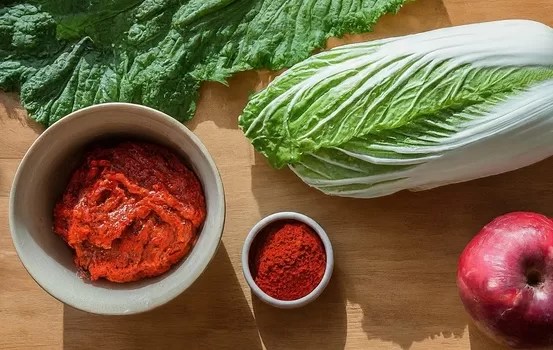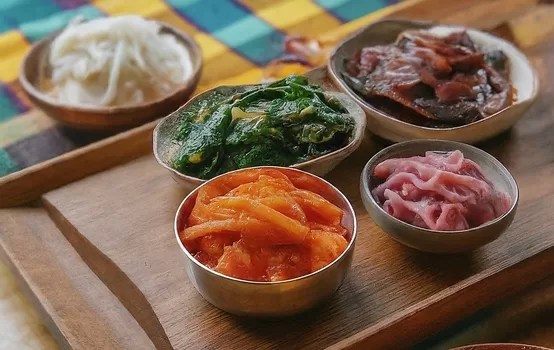Korean cuisine, renowned for its rich flavors and diverse dishes, owes much of its unique taste to the ancient practice of fermentation. This time-honored technique not only enhances the flavors of the food but also boosts its nutritional value, making fermented foods a staple in Korean households. From the fiery kick of kimchi to the savory depth of doenjang, let’s delve into the fascinating world of Korean fermented foods.
Chae: Korean slow food for a better life Hardcover, 2024 is available from Amazon
Our best Korean recipes continues after this advertisement:
Kimchi: The Quintessential Korean Side Dish
No discussion about Korean fermented foods is complete without mentioning kimchi. This iconic dish, made from fermented vegetables, primarily Napa cabbage and radishes, is seasoned with chili powder, garlic, ginger, and other spices.
The fermentation process imparts a distinctive tangy flavor while enriching the dish with probiotics, which are beneficial for gut health.
Kimchi is versatile, enjoyed as a side dish, in stews, or even in pancakes. Besides its flavorful punch, kimchi is rich in vitamins A, B, and C, packed with probiotics for digestive health, and is low in calories while high in fiber.
Doenjang: The Heart of Korean Soups and Stews
Doenjang, a fermented soybean paste, is another cornerstone of Korean cuisine. Made from soybeans and brine, it undergoes a lengthy fermentation process, developing a deep, earthy flavor.
Doenjang is the star ingredient in many traditional Korean soups and stews, such as doenjang jjigae, a hearty soybean paste stew with vegetables and tofu.
This paste is not only high in protein and essential amino acids but also contains beneficial enzymes and microorganisms that aid in digestion and lower cholesterol.
Traditional Doenjang Recipe (Korean Fermented Soybean Paste)
Gochujang: The Spicy-Sweet Red Pepper Paste
Gochujang, a fermented red pepper paste, adds a sweet and spicy kick to many Korean dishes. Made from red chili powder, glutinous rice, fermented soybeans, and salt, gochujang is aged for months, allowing its flavors to meld and intensify.
It’s a key ingredient in bibimbap, tteokbokki (spicy rice cakes), and various marinades.
Gochujang is special because it adds depth and complexity to dishes, contains capsaicin that boosts metabolism, and acts as a natural preservative due to its fermentation process.
Jeotgal: The Savory Fermented Seafood
Jeotgal refers to various fermented seafood products, such as salted shrimp, oysters, and fish. These intensely flavored condiments are used sparingly to enhance the taste of dishes.
For instance, saeu-jeot (salted shrimp) is often added to kimchi to deepen its flavor during the fermentation process. Jeotgal stands out for its high protein and essential minerals content, its ability to add umami flavor to dishes, and its role in enhancing the fermentation process in other foods.
Makgeolli: The Traditional Korean Rice Wine
Makgeolli is a traditional Korean rice wine made from fermented rice, water, and nuruk (a fermentation starter). This milky, slightly sweet alcoholic beverage has a low alcohol content and is enjoyed for its refreshing taste and probiotic benefits.
Makgeolli pairs well with Korean pancakes (jeon) and other savory dishes. It is appreciated for containing lactic acid bacteria beneficial for gut health, being rich in amino acids and vitamins, and having a low alcohol content that makes it a light, refreshing drink.
Our Traditional Makgeolli Recipe (Korean Rice Wine) is here.
Embracing the Fermented Food Culture
Fermented foods are more than just a culinary tradition in Korea; they are an integral part of the culture and daily life. The practice of fermentation dates back centuries, preserving food in times of scarcity and enhancing the flavors of the Korean diet.
Whether you’re a foodie looking to explore new tastes or someone interested in the health benefits of fermented foods, Korean cuisine offers a delectable and nutritious journey.
The world of Korean fermented foods is vast and varied, offering a rich tapestry of flavors and health benefits. From the spicy tang of kimchi to the umami depth of doenjang, these foods showcase Korea’s culinary ingenuity. Embrace the art of fermentation and add a touch of Korean tradition to your dining table. Your taste buds—and your gut—will thank you.

Related stories
Recipe for popular Korean dish Gimbap
Traditional Doenjang Recipe (Korean Fermented Soybean Paste)
Traditional Makgeolli Recipe (Korean Rice Wine)
Chinese Restaurant Syndrome – is MSG safe?
Recipe for popular Korean dish Gimbap
Australia’s best tasting heirloom tomatoes
Delicious and Easy Air Fryer Recipes
A True History of Vegemite, manna from Heaven
Global Food Production Dilemma: Grow & Buy Local
Lunar Agriculture: Plants to be Grown on the Moon
Should You Buy at Farmer’s Markets or Supermarkets?
Are Salt and Pepper Shakers collectible? What to look for
What to look for when collecting Egg Cups
Western Sydney Oyster Festival Surprises in August, Shucks!




